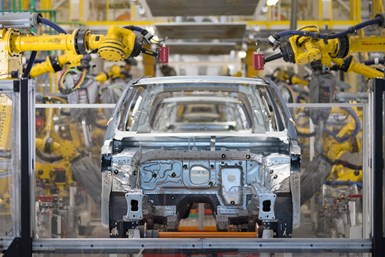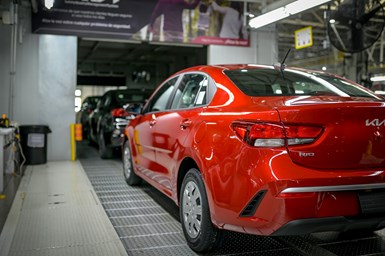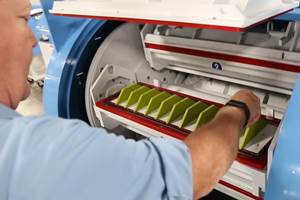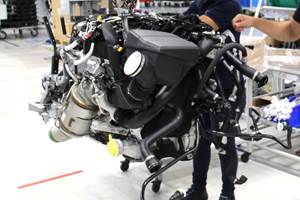According to the document "To regionalize or not? Optimizing North American supply chains", presented by McKinsey, companies in North America have a lot to consider when deciding whether to fully or partially regionalize their production and supply chain to meet market needs.

The McKinsey report identified ten industries with strong regionalization viability, such as semiconductors.
It notes that to stay ahead in an unpredictable global economy, companies are incorporating speed and agility into their operations and, they point out, supply chain configuration is a priority.
As such, companies are considering manufacturing and sourcing in the region, not only to gain a cost advantage, but also to increase resilience.
"Approximately 40% of companies are revising their supplier base to be closer to their core markets, which in many cases are in North America," the McKinsey document notes.
The firm specifies that the way in which companies decide to regionalize depends on their individual situations. It notes that some industries are better positioned than others and points out that changes in production are not always possible, especially when value chains are highly integrated, or the specific competitive advantage of each country is strong.
"The impact of regionalization is specific to each industry and sector. However, some industries are particularly affected by changes in global trade and have a strong case for regionalizing part of production in the manufacturing and supply chain," the document points out.
According to the McKinsey report, ten industries with strong regionalization viability have been identified:
- Medical devices
- Semiconductors and electrical components
- Computer systems and electronics
- Pharmaceuticals
- Automotive
- Electrical Equipment
- Machinery & Equipment
- Chemical products
- Cellular/mobile communication equipment
- Aerospace
"Demand for these sectors is likely to increase across North America. They are also driven by non-economic factors, such as government support and economic drivers. Likewise, they are likely to see greater changes in their production facilities and supply chains due to regionalization," the document details.
For example, the document notes, for certain products in sectors such as automotive, electronics or medical devices, manufacturing abroad may no longer be the cheapest option to supply the North American market.
He adds that the relatively high material costs in North America (20% to 25% higher than in traditional manufacturing centers) can be offset by the impact of non-material costs, such as labor, transportation and tariffs.
"Moving certain production lines of these industries to Mexico could represent savings between 15% and 25% of the total cost at destination," the document states.
It also notes that a U.S. facility may have a similar cost profile to an overseas facility, with greater proximity to end users.
The paper notes that, given the total cost at destination, there could be compelling reasons for regionalization.
"Within North America, each country offers unique conditions. Those moving into the region or increasing their existing presence can choose from a variety of environments and market considerations," the document notes.
For example, the report notes, the U.S.-Mexico-Canada trade agreement (USMCA) has expanded trade incentives, along with stricter rules of origin (so intraregional auto manufacturing is flourishing).
The agreement also strengthens patent and intellectual property protection, boosting industries such as pharmaceuticals and aerospace.
"Factors such as self-sufficiency, national security and technological development influence the location of industries. The U.S. Congress has passed the Creating Helpful Incentives to Produce Semiconductors (CHIPS) and Science Act, precisely to promote semiconductor manufacturing," the report details.
Likewise, in the United States, communication technologies and space technologies and systems are now considered relevant to national security.
For its part, Canada is investing approximately US$750 million in the "Global Innovation Clusters" program, which aims to accelerate the country's technological development. Support is also being given to the aerospace industry, medical technology, and next-generation technology.
The paper adds that Mexico's high manufacturing base makes it attractive to labor-intensive industries. Similarly, its lower inland logistics costs are key for industries where transportation costs are inherently high due to the volume of products.
"Mexico has sectoral promotion programs that allow preferential tariffs to be applied to inputs for the manufacturing industry," the document states.
To read the full Mckinsey paper, please visit the following link.
Relocation In Mexico, A Growth Opportunity for The Whole Country
According to the Ministry of Economy, there are five industrial sectors in Mexico that will be boosted by relocation:
- Semiconductors
- Automotive (electromobility)
- Electrical and electronics
- Medical devices and pharmaceuticals
- Agroindustry
The federal agency called on the country's 32 states to draw up a work plan for the next two years, which should contain a diagnosis of the productive vocation of each state, as well as the simplification of procedures so that they can be standardized at a national level.
In this way, the head of the agency, Raquel Buenrostro, said that all states are potential candidates to receive investments.
"Mexico is in the best moment, due to its geopolitical position, which allows us to generate development poles in the different regions of the country," said Buenrostro.
In this regard, Samuel García, governor of Nuevo León, said that Mexico, and Nuevo León in particular, are in a totally favorable scenario for companies that adopt nearshoring as a relocation strategy.
"The proximity to the United States, the industrial infrastructure that has been developed in recent years, lower labor costs and the T-MEC place our country and our state as the natural destination to take advantage of the transfer of production chains from Asia to America," he said.
He detailed that the border with the United States, together with skilled labor, infrastructure, and a solid supplier base, make Nuevo León an advantageous destination for investors.
"Among the countries with more projects in the state are the United States, with investments such as The Home Depot, Navistar and Hershey's; China, with projects such as those of Man Wah, BUT Construction Machinery and LGMG; and South Korea, especially with KIA Motors and its new investment for expansion," said the state governor.

KIA Motors announced an investment of US$408 million for the growth of its operations in the state of Nuevo Leon. Photo: Gobierno de Nuevo León.
He added that there are also European companies, for example, Germany has completed projects with Siemens and Bosch and Denmark has started the expansion of LEGO.
"There are always many challenges to be faced in the context of continued economic growth, such as those related to mobility and the environment," he said.
It should be noted that, according to the Inter-American Development Bank (IDB), Latin America and the Caribbean could increase their exports annually by 78 billion dollars in the short and medium term thanks to nearshoring.
Mexico would be the Latin American country with the greatest opportunities in this sense, since it could add 35.3 billion dollars annually, only considering the export of goods.
Likewise, from January to September 2022, a Foreign Direct Investment of 32,147.4 million dollars was recorded, 29.5 % higher than that recorded in the same period of 2021.
Of the total investment, the manufacturing sector received 36.3%.
Contenido relacionado
Soluciones avanzadas de manufactura para componentes de precisión
Con cuatro nuevos centros de mecanizado de 5 ejes y dos células PH Cell Twin de DMG MORI, esta compañía refuerza su compromiso con la excelencia en la manufactura para sectores exigentes como el automotriz, médico y aeroespacial.
Leer MásMéxico: perspectivas de crecimiento para la industria de autopartes
En 2023, la industria de autopartes en México prevé un crecimiento del 10.45 %, con un valor de producción de USD 115,802 millones, esto pese a desafíos como la huelga de UAW en EE. UU. El nearshoring ha jugado un papel clave.
Leer MásAcabado automatizado en CNC: barriles de alta energía
Mass Finishing Inc. ha desarrollado máquinas de acabado con barril de alta energía que automatizan el proceso de desbarbado de partes complejas, lo que ahorra tiempo y elimina la necesidad de desbarbar las partes a mano.
Leer MásIndustria automotriz inicia 2023 con crecimiento en sus exportaciones
En enero de 2023 la exportación de vehículos ligeros aumentó 9.9 %, comparada con enero de 2022. Además, la producción creció 2.38 % en el mismo periodo.
Leer MásLea a continuación
Por qué usar torneado tipo suizo
¿Para qué clase de producción se usan los tornos tipo suizo? ¿En qué se diferencian de los centros de torneado convencionales? Expertos y usuarios cuentan sus experiencias.
Leer MásSistemas innovadores de sujeción para electroerosión y mecanizado de tres ejes
Con el propósito de aumentar el índice de ocupación de máquinas en el taller, este fabricante de moldes adaptó un dispositivo de sujeción en sus máquinas de tres ejes y su electroerosionadora de penetración para aumentar la flexibilidad de sus equipos y ser más competitivo.
Leer Más10 tendencias que se están tomando los talleres metalmecánicos mexicanos
Modern Machine Shop México resume las tendencias y tecnologías a observar por parte de los talleres de mecanizados en México.
Leer Más





















